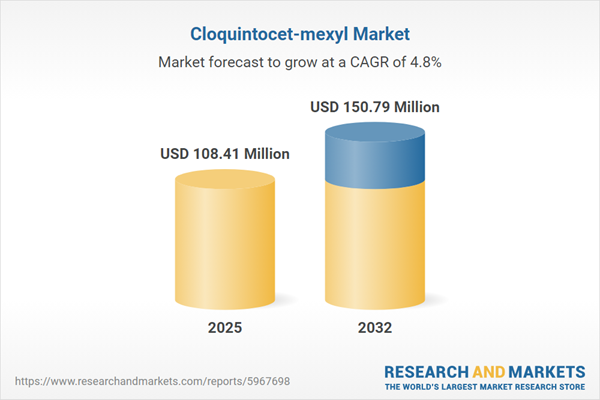Speak directly to the analyst to clarify any post sales queries you may have.
The cloquintocet-mexyl market is undergoing significant transformation as agricultural enterprises respond to tightening regulations and rising sustainability expectations. For senior decision-makers, adaptive supply chains and proactive strategy remain essential to maintain competitive edge and support evolving crop protection objectives.
Market Snapshot: Cloquintocet-mexyl Market Size and Growth Outlook
The cloquintocet-mexyl market is projected to grow from USD 103.51 million in 2024 to USD 108.41 million in 2025, and further to USD 150.79 million by 2032. This expansion is fueled by increased investments in advanced crop protection technologies, accelerated adoption of digital tools for compliance, and efforts to broaden application methods. Businesses are prioritizing robust supply chain networks and closer collaboration, reflecting the market’s need for flexible strategies that accommodate diverse regional frameworks and variable levels of technological development. Informed operational decisions help leaders respond swiftly to new opportunities and manage sector risks.
Scope & Segmentation
- Distribution Channel: Organizations benefit from both conventional and online procurement, supporting streamlined integration of technical systems and enabling sourcing tailored to distinct operational requirements.
- Application Method: Foliar sprays and seed treatments allow targeted active ingredient application, promoting resource efficiency and supporting yield stability within sustainable agricultural practices.
- End User: Solutions address the needs of commercial growers and smallholder farmers alike, enabling access to productivity gains across various operation sizes and farming models.
- Application: The market covers use in cereals and oilseeds, offering relevance for enterprises seeking to diversify crop assortments and adapt to changing agronomic or environmental conditions.
- Formulation: Emulsifiable concentrates, suspension concentrates, water-dispersible granules, and wettable powders offer adaptability to varying workflows and field conditions, optimizing efficiency for each application.
- Region: Distinct regulatory, digital, and agro-technical factors influence strategies across the Americas, Europe, Middle East, Africa, and Asia-Pacific, impacting both local innovation and broader market entry approaches.
- Companies Profiled: Market development is shaped by players including Bayer CropScience AG, Corteva Agriscience LLC, BASF SE, Syngenta International AG, FMC Corporation, UPL Limited, ADAMA Agricultural Solutions Ltd., Sumitomo Chemical Co., Ltd., Nufarm Limited, and Isagro S.p.A., who are advancing product innovation and fostering collaboration across regions.
Key Takeaways for Decision-Makers
- Increasing compliance requirements require organizations to advance crop safener portfolios and strengthen oversight in their internal processes.
- Technology integration, including digital and machine learning tools for input management, enhances operational agility and supports responsive decision-making.
- E-procurement processes, when combined with established partnerships, help organizations access real-time support and adapt to evolving market conditions quickly.
- Product portfolios are becoming more versatile to serve both large enterprises and smaller agricultural operators aiming for efficiency and flexibility.
- Sustainability is embedded within product development, supporting alignment with environmental standards and regulatory priorities across the industry.
- Collaboration in R&D and on-field validation accelerates market responsiveness and assists in timely adaptation to regulatory changes and technological progress.
Tariff Impact on Supply Chain
Recent changes in U.S. tariff policy have introduced additional challenges for cloquintocet-mexyl supply chains. In response, manufacturers are reassessing production and distribution locations, considering near-shoring options, and expanding dynamic inventory management practices. Digital supply chain platforms are increasingly being used to enhance transparency year-round, enabling stakeholders to coordinate distribution activities more effectively.
Methodology & Data Sources
This analysis draws on technical literature, regulatory data, and insights from expert interviews in R&D, compliance, and supply chain management. By combining these sources, the findings are designed to be directly relevant to organizational leaders aiming to reduce operational risk and inform strategic direction.
Why This Report Matters
- Senior leaders gain clear frameworks to navigate regulatory changes and integrate digital solutions in the cloquintocet-mexyl market.
- Strategic segmentation and detailed competitor insight support informed investment and partnership choices amid ongoing sector disruption.
- Comprehensive evaluation of R&D, compliance, and sustainability equips executives to address market complexity and benchmark progress.
Conclusion
Resilience in the cloquintocet-mexyl market depends on agile planning and informed navigation of regulatory change. Leaders who foster ongoing innovation and operational flexibility can position their organizations for sustainable success as industry conditions continue to evolve.
Additional Product Information:
- Purchase of this report includes 1 year online access with quarterly updates.
- This report can be updated on request. Please contact our Customer Experience team using the Ask a Question widget on our website.
Table of Contents
3. Executive Summary
4. Market Overview
7. Cumulative Impact of Artificial Intelligence 2025
Companies Mentioned
The companies profiled in this Cloquintocet-mexyl market report include:- Bayer CropScience AG
- Corteva Agriscience LLC
- BASF SE
- Syngenta International AG
- FMC Corporation
- UPL Limited
- ADAMA Agricultural Solutions Ltd.
- Sumitomo Chemical Co., Ltd.
- Nufarm Limited
- Isagro S.p.A.
Table Information
| Report Attribute | Details |
|---|---|
| No. of Pages | 183 |
| Published | November 2025 |
| Forecast Period | 2025 - 2032 |
| Estimated Market Value ( USD | $ 108.41 Million |
| Forecasted Market Value ( USD | $ 150.79 Million |
| Compound Annual Growth Rate | 4.8% |
| Regions Covered | Global |
| No. of Companies Mentioned | 11 |









